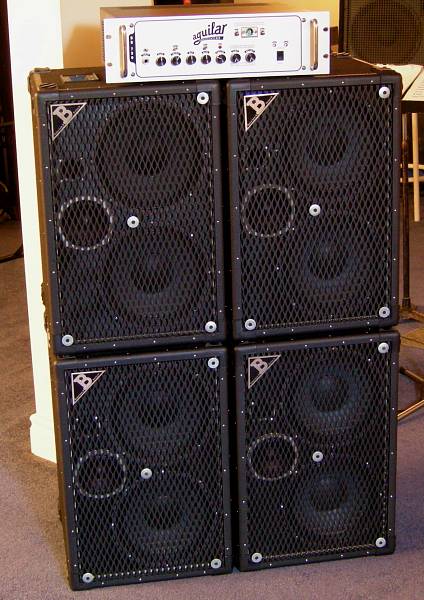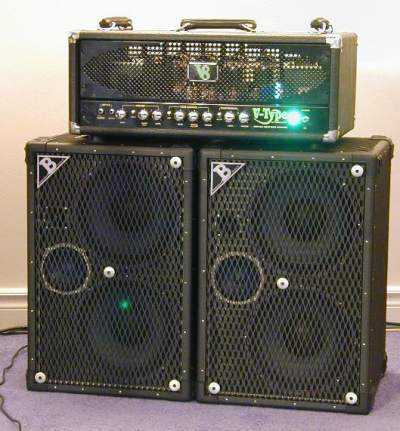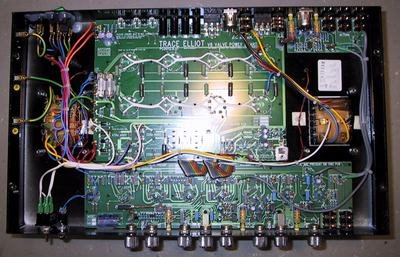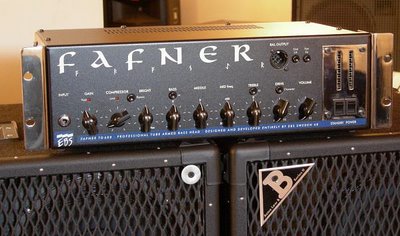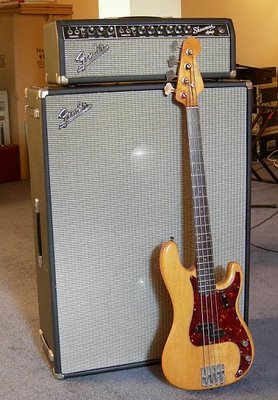Aguilar DB680 preamp / DB728 poweramp
The
DB680 is a great preamp and has certainly become a fixture / standard in many recording studios. In combination with the
DB728 however, the sum is much greater than all of the parts. Clearly Mr. Boonshoft was able to work some magic by designing both pieces to compliment one another perfectly.
Specifications, from the Aguilar website:
DB680
Dual Parametric Equalization: Two serially arranged active networks. plus/minus 12 db. One EQ is set up from 180 Hz fully variable to 1.2K with fully adjustable bandwidth (Q), and level controls. The other EQ is set up to be fully variable from 1.3K to 7.5 K, again with fully variable bandwidth and level (boost and cut). By arranging the EQs in this fashion we can offer complete flexibility.
Tube EQ
Treble: Tube driven shelving, plus/minus 12db @ 4 K HZ Bass: Tube driven shelving, plus/minus 12 db @ 40 Hz Bass: Tube driven shelving, plus/minus 12 db @ 40 Hz Deep Switch: 2 position tube driven RLC resonant EQ, fixed at 30HZ Bright Switch: Passive RC premphasis @ 5-7 K Hz
Tube effects loop: Tube parallel effects loop with adjustable send and mix control. Left and right returns for stereo effect units.
Output Interfaces: Two 1/4" jack line level output controlled by the master volume control provides unbalanced tube-buffered output for connection to a power amp.
XLR balanced output: Unlike conventional DI outputs, this balanced configuration allows the player to record directly to tape. No mic-pre is required! The output level has five positions to cover all possible recording and concert situations. They are: -40db pre-EQ, -40 db post EQ, 0db, 2db, and 4 db.
HI and Low 1/4" phone jacks: These provide individual crossover outputs for full bi-amping capability. Each has its' own front panel level control and the crossover frequency is adjustable from 100 Hz to 1000 Hz.
Input Interfaces: Two selectable inputs: Located on the front panel, selectable by front panel switch or by footswitch.
Auxiliary input: Located on the rear panel. The extra input on the rear panel is useful in a permanent studio or live rack set-up where one needs to access the unit from behind.
Input thru: This is used to send the signal from a bass straight through to the input of another bass head (not a power amp). For example, connecting with a vintage bass amp that you want to record with a microphone, while taking a direct signal from the DB 680.
Footswitch: Allows the player to select input one or two. Also on the footswitch is a master mute control which mutes all signal except signal going to the tuner input (an extremely useful feature in live or studio situations).
Tube complement: Two 12AX7A/7025 high-mu twin triodes Three 12AU7 medium-mu twin triodes
Input Impedance: 1 M ohm (passive mode) 47 K ohm (active mode)
Output Impedance: Nominal output = 600 ohm. Balanced output = 75 ohm Crossover outputs = 75 ohm.
Power requirement: 100-120-220-240 VAC 50-60 Hz (internally selectable)
Power consumption: @ 120 VAC: 0.75A, 87.75 W
Rack Size 2 spaces
Weight:17 lbs
DB728Power Output: 400 watts RMS. Into 2, 4, or 8 ohms.
Tube Compliment: Eight 6550 power tubes, one 12AX7, one 12U7
Power Consumption: 1.8A @ 120 VAC zero signal condition.
Power requirement: 100, 120, 220, 230 VAC
Transformers: Custom designed toroidal output transformer for ultra-wide bandwidth. Power transformer is also toroidal.
Cooling: Two ultra-low noise fans regulate the operating temperature of the amp.
Inputs: One 1/4" unbalanced input and one input thru for patching a preamp signal thru to an additional power amp.
Input Impedance: 470k Ohms.
Output Impedance Selector: A three position switch provides switching for two, four, and eight ohms.
Outputs: Two speak on connectors and two 1/4" outputs
Chassis: High quality aluminum construction provides sturdiness without excessive weight. Access to tubes is provided through top of unit for convenience and is isolated from any dangerous voltages.
Warranty: Ten year limited warranty.
Weight: 4 rack spaces, 57 lbs.
Preamp & Poweramp CombinedTo say that I wasn't prepared for this combination would be understatement. It's easy to be excited about new gear, but the proof is always what happens in a live scenario with other players. My cautious optimism was replaced by unbridled enthusiam. Having had the opportunity to look inside I can say with certainty that this is the most overbuilt and well-designed tube amp that I've ever seen. To quote someone we all know and love (Psycho Bass Guy) "... built better than most old Navy tube radios. I see why they don't want to make that many to sell. They are electronic works of art and HAVE to be beyond labor intensive to produce". Exactly right. These have both been recently discontinued.
This combination is capable of sounds very similar to that of a vintage ('68-'71 era) SVT with lots of grunt; buttery, warm, smooth, fat and gritty if pushed hard. I tried the DB680/DB728 with 2 power-hungry Acme Low B2-II cabinets and the pair performed unbelievably!
It's extremely obvious that the
DB680 and
DB728 were made for each other. For a tube amplifier, this combination is voiced perfectly. There is a massive amount of power and headroom available. Sound? I've never heard an all-tube amp sound more authoritative. All of the warm, fat lows are there and the overall sound is s-m-o-o-t-h and punchy, with as much or as little grit as you want.
 I was so impressed with the RH450 amp that when TC Electronic announced a limited production of handmade amps from Denmark I ordered one immediately. This is the flagship model of TC Electronic's "Bass 2.0" amp lineup.
I was so impressed with the RH450 amp that when TC Electronic announced a limited production of handmade amps from Denmark I ordered one immediately. This is the flagship model of TC Electronic's "Bass 2.0" amp lineup.





